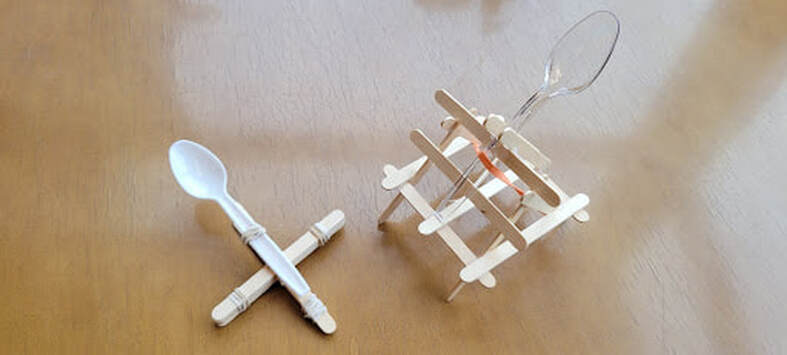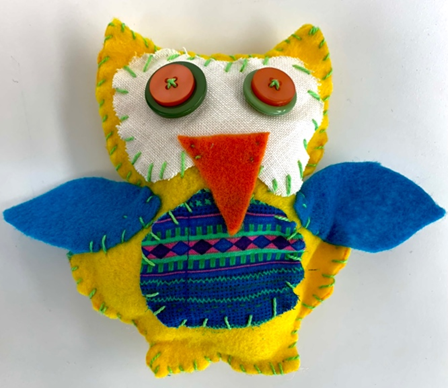|
Experiment with popsicle sticks, plastic spoons, and rubber bands to create your own catapult!
A catapult is a lever device designed to launch projectiles without the aid of propellants or fuel. Most catapults use tension energy that is gradually stored, and then released all at once to launch the projectile. A good example of this is a slingshot, which is actually a simple catapult! As the band of the slingshot is pulled back, the band is loaded with tension energy - the further you pull back, the more energy is stored in the band. When you let go, the band releases that energy all at once, snapping back into place and flinging your object away. In ancient times catapults were used in siege warfare, but are mainly used now for launching airplanes from aircraft carriers! To build a simple popsicle stick catapult, watch this video from Youtube STEM and craft creator Denise Bertacchi. To get ideas for a more complex design, check out this Accurate Catapult with Popsicle Sticks video from high school physics teacher and creator Raymond Burns. Once you understand the basics, experiment to create your own catapult design! What happens if you move the fulcrum - the supporting popsicle sticks underneath your plastic spoons? When you bend the spoon back you are applying force to the catapult. The fulcrum is transferring the force from bending back the spoon to shooting your ammo. What happens when the fulcrum is closer to the spoon head? What happens when the fulcrum is farther from the spoon head? To learn more about the history of catapults, check out this article from Britannica Library Young Adult. To learn about simple machines and the physics behind them, learn more at Britannica Library Children. To translate these pages into Spanish, click on the globe icon and select “Spanish” from the drop down menu. Projecto de Arte para llevar a casa: Catapultas de palitos de helado¡Experimente con palitos de helado, cucharas de plástico y gomas elásticas para crear su propia catapulta!
Una catapulta es un dispositivo de palanca diseñado para lanzar proyectiles sin la ayuda de propulsores o combustible. La mayoría de las catapultas usan energía de tensión que se almacena gradualmente y luego se libera de una vez para lanzar el proyectil. Un buen ejemplo de esto es una honda, que en realidad es una simple catapulta. A medida que la banda de la honda se tira hacia atrás, la banda se carga con energía de tensión: cuanto más se tira hacia atrás, más energía se almacena en la banda. Cuando lo sueltas, la banda libera esa energía de una vez, volviendo a su lugar y arrojando tu objeto. En la antigüedad, las catapultas se usaban en la guerra de asedio, ¡pero ahora se usan principalmente para lanzar aviones desde portaaviones!
Para construir una catapulta de palitos de helado simple, mira este video de Youtube STEM de la creadora de manualidades Denise Bertacchi. Para obtener ideas para un diseño más complejo, vea este video de Catapulta precisa con palitos de helado del maestro de física y creador de la escuela secundaria Raymond Burns. Una vez que comprenda los conceptos básicos, ¡experimente para crear su propio diseño de catapulta! ¿Qué sucede si mueves el fulcro (punto de apoyo), los palitos de paleta de soporte debajo de tus cucharas de plástico? Cuando dobla la cuchara hacia atrás, está aplicando fuerza a la catapulta. El fulcro transfiere la fuerza de doblar la cuchara hacia atrás para disparar la munición. ¿Qué sucede cuando el fulcro está más cerca de la cabeza de la cuchara? ¿Qué sucede cuando el fulcro está más lejos de la cabeza de la cuchara? Para obtener más información sobre la historia de las catapultas, consulte este artículo de Britannica Library Young Adult. Para aprender sobre máquinas simples y la física detrás de ellas, aprenda más en Britannica Library Children. Para traducir estas páginas al español, haga clic en el icono del globo terráqueo y seleccione "Español" en el menú desplegable.
0 Comments
Take pictures and email to info@theartbase.org or Kristen Doyle, kdoyle@basaltlibrary.org. Cose un búho de peluche
Learn how to create a variety of fun friendship bracelets with this tutorial from CreativeBug! CreativeBug hosts a variety of arts and crafts video classes, and can be accessed for FREE with your library card. Follow the steps below to access Twinkie Chan’s Make Friendship Bracelets class. Materials
Instructions
Projecto de Arte para llevar a casa: CreativeBug Pulseras de hilo encerado de la Amistad¡Aprende a crear pulseras de hilo encerado de la amistad con este tutorial. Tutoriales Belen es un canal conocido de YouTube en español que publica nuevos videos de manualidades cada semana. Con los materiales incluidos en su kit para llevar y algunos artículos de su casa, puede aprender a crear pulseras de hilo encerado de colores, viendo los tutoriales disponibles en el enlace a continuación. Materiales
Instructions
|
Adult News & reviewsLibrary news, info about upcoming events, reviews of books and films, and a look at the topics that affect us as a library. Archives
July 2023
|
General |
Borrowing |
About |



 RSS Feed
RSS Feed
